I saw and article by Bill Schopp on making an Erie 0-8-8-0 Camelback Articulated , and I have to say now I really want to look into more of his work. I was really taken by the idea and made me think of applying it to make like D&RGW L-95 and L-96 2-8-8-2's. I was even thinking along the lines of doing stuff like that using AHM 2-8-8-2 chassis.
- Welcome to Bachmann Online Forum.
News:
Please read the Forum Code of Conduct >>Click Here <<
This section allows you to view all posts made by this member. Note that you can only see posts made in areas you currently have access to.
#137
HO / Re: What if the D&RGW had a 2-10-4? A Kitbash story~
August 12, 2013, 12:44:05 AMQuote from: electrical whiz kid on August 11, 2013, 07:50:55 AM
Hi, Rye;
Great job. I share your philosophy about "sameness" and (as you know) have no problems with doing justice to a locomotive.
Many years ago, the late Bill Schopp fired up my ambitions with his "well, here goes nothing" approach to taking a brass locomotive and rebuilding it. I was in SEA when I first got interested in this segment of the hobby, and certainly endorse your efforts. Oh; I decided to build another "green-card Mike". OK, well great job, and looking forward to reading more, especially on your work here.
Rich C.
Rich,
we still need to get together some time and talk and show each other some of the neat stuff we get into, and maybe you can share some insight on what a career would be like as an electrician, I've been giving it some thought lately. How do those SY mikado's run anyways, I have one holed up in a basement in East Hartford, though I think it's long gone now. I'd be one to convert them, Americanize them if you will, but Box-pok drivers aren't my thing, although I'm not completely senslaved to sticking to that. I will definitely have to look up Bill Schopp, the name sounds familiar.
Thomas, the biggest resource I use is the internet. Mainly because of the vast amount of pictures floating around, and I also visit brass dealer sites daily. Those provide adequate inspiration and helpful hints as to where things go. To be honest the 2-10-4 is lacking AIR TANKS! But That's an easy fix. Two of my M-75 4-8-2's had elesco feedwater heaters, which I'm not much a fan of, so I removed them and I had to move the piping around and all that. They're still incomplete, because they need to be fitted with Worthington feedwater heaters.

Another great resource is model railroader magazines from the 40's 50's and 60's which contain a lot of steam detailing tips from a time where selection wasn't that great and you HAD to go brass for uniqueness. When I study a steam locomotive, I break it down into groups, first the running gear and the wheels, the unique thing about the Rio Grande mountains is that they had the eccentric crank and drive rods connected to the third set of wheels, not the second set like found on USRA and other typical 4-8-2's which makes them extremely difficult to model in plastic unless you know how to move all that around. The next group I look at is the boiler and the domes and the various shapes and sizes and the tapering of the boiler and the shape of the firebox. Every railroad had their distinct characteristics that separated them from each other, that's the beauty of American railroading is the personality connected to the roads the engines ran on, like wheel arrangement all the way down to the headlight's and marker lights. They're the eyes and noses of the locomotive like the feedwater heaters are like foreheads. I hope you're catching the analogy I trying to present.
For typical D&RGW engine, they used Pyle headlights, Handlan Radius style marker lamps, Number boards, and a specific D&RGW pilot as well. Of course the 2-10-4 is completely like that but I did use a few of the aforementioned parts.
A good reference guide/book would be the PSC Precision Scale Co. HO and HOn3 Steam locomotive Super detailing parts catalog, and inside it'll show you various odds and ends you might need to personalize your locomotives as well as piping diagrams.
Always feel free to ask, there's no such thing as a dumb question, with everything I've done in life, I started from the bottom bare basics.
And no you're not cluttering my thread at all, I'm always open to discussions, that's why I always come back here!

#138
HO / Re: Matching chuff rate on HO 2-8-0 ?
August 10, 2013, 11:43:38 PM
It surprises me that Bachmann hasn't implemented a chuff exhaust cam on their sound locomotives, and I wonder on top of that if it were to easy to install it on already existing sound equipped locomotives. 

#139
HO / Re: What if Bachmann made a 2-6-6-0?
August 10, 2013, 11:24:23 PMQuote from: GN.2-6-8-0 on August 10, 2013, 08:43:32 PM
Curious as to how the bachmann running gear is holding up with the heavier brass superstructure?
It's actually maybe a couple ounces heavier than the original 2-6-6-2 shell, not to mention the chassis had to be milled properly so the boiler could fit on, so weight reduction was involved. So I'd say it weighs roughly the same as the original Spectrum model with a subtraction of space it takes.
J3a,
I remember that discussion quite well and whenever I'm busy kitbashing I'm always thinking of those possibilities, I still have a couple Bachmann aux. tenders set aside for a N&W Z1 I plan to do.
#140
HO / Re: What if the D&RGW had a 2-10-4? A Kitbash story~
August 10, 2013, 11:19:11 PMQuote from: WoundedBear on August 10, 2013, 08:27:05 PM
Although I'm not a particular fan of the SUBJECTS you model, I most certainly am a fan of your ABILITIES. For a fellow as young as you to have developed such skills, shows me you either had a hell of a good teacher or you have a ton of passion. Either way, your modelling is spot on.
And don't even get me started on your writing abilities. What a joy to sit and read something that's actually comprehensible. Good photography too, BTW.....but why doesn't that surprise me.
Good job young man.
Sid
That may have well been one of the best compliments I've ever received, thank you!
I didn't really have much of a teacher in my adolescence, I basically started off with playing with broken down locomotives in a box of other destroyed model trains like Mantua Mikados and Pacifics with the pieces missing. Eventually when I entered grammar school, in my rebelliousness would sneak into my father's collection of MDC steam locomotive kits and build them up, run them, and take them apart, build them again, rinse wash repeat until the engines could no long be rebuilt and they remain as kitbashing fodder until an idea comes again.(I do have some circulating involving the 0-6-0 switchers)
Eventually I moved up to purchasing some of my own power, cheap plastic steam locomotives and tinkering with those. But I always had a dream to own brass and maintain a fleet. I don't like locomotives that look like something everyone else has on their pike. I feel this mentality had something to do with flipping through the pages of Model Railroading with John Allen until the binding disintegrated so now it's loose pages. The skills I've acquired are mostly the product of trial and error, much as you see from the project chronologically. I was pretty hesitant at first to cut the engine up, but the final product made it worth that leap.
This engine is pretty much the first Brass piece I actually bought with my own money, so to give it dignity really means something, and it will definitely stay with me for the rest of my life.
As far as my writing is concerned, I do write on other forums like Facebook in a different way, but I've learned to write respectably with adults and forums such as these. It also comes from being a member of this forum since 2007? I think it is? Where members have sought out to write with good grammar, so I figure I would disappoint.

Jonathan,
There is some B&O power that I like, such as the E-27 2-8-0, simply because John Allen had one, and I want to replicate it, which he didn't modify that much. The Bachmann EM-1 might be considered for a future project, the tender and the obvious B&O characteristics would not stay of course. I have a B&O 2-10-2 boiler that I'm hoping to put on a 2-8-8-2 or 2-6-6-2 chassis and the 4-6-2 streamlined Pacifics I rather like as well.
But right now I have a few projects I need to FINISH before I start new ones, which is a bad habit of mine because I tend to dream big. I have a 2-8-2 and a 2-10-2 in the works soon,
Some of my inspiration does come from your posts, so don't stop what you do either, I actually would like to see you create some B&O variant articulateds like the 0-6-6-0, 2-6-6-4 and a 2-8-8-2 just to see how you would approach a project like those.
#141
HO / Re: What if the D&RGW had a 2-10-4? A Kitbash story~
August 10, 2013, 07:17:55 PMQuote from: Doneldon on August 10, 2013, 05:54:49 PM
Rye-
Beautiful work. I have to admit, I thought at first that swapping out the tender was a bit silly, even if the Rio Grande never had handrails all around, but your final outshopping photo shows me that I was mistaken. The replacement looks perfect with the Texas. Your paint and weathering are first class, too. I just can't say enough about your work. It is downright excellent. And I'm not ordinarily a gusher!
-- D
Well thankfully, PFM imported just the tenders for some models, I don't know why... maybe for roundhouse filler? But I got it for a good deal from Caboose Hobbies in Denver, I saw the clear vision tender as looking very out of place for such a large locomotive so I felt a big tender from an articulated would do the trick, and it matches quite well! I couldn't stand the welded look of the original DM&IR tender, it looked out of place for me.
Weathering is done by brush, with grimy black for paint and mixtures of white grey and black pastel chalks applied by a dry brush. I tend to find the chalk dust effect works well with creating realism and I add it when the paint isn't 100% cured so it actually sticks a bit.
But thank you, I took that as a good compliment, I like to think of the engine being a big learning process in kitbashing. I thought I was never going to find love in it again until I came up with these ideas.
#142
HO / What if the D&RGW had a 2-10-4? A Kitbash story~
August 10, 2013, 05:06:30 PM
This engine started life as an LMB KMT Brass DM&IR 2-10-4



I didn't like the tender, and the running capability of the locomotive left much to be desired, so it went off to the Kitbasher's torch
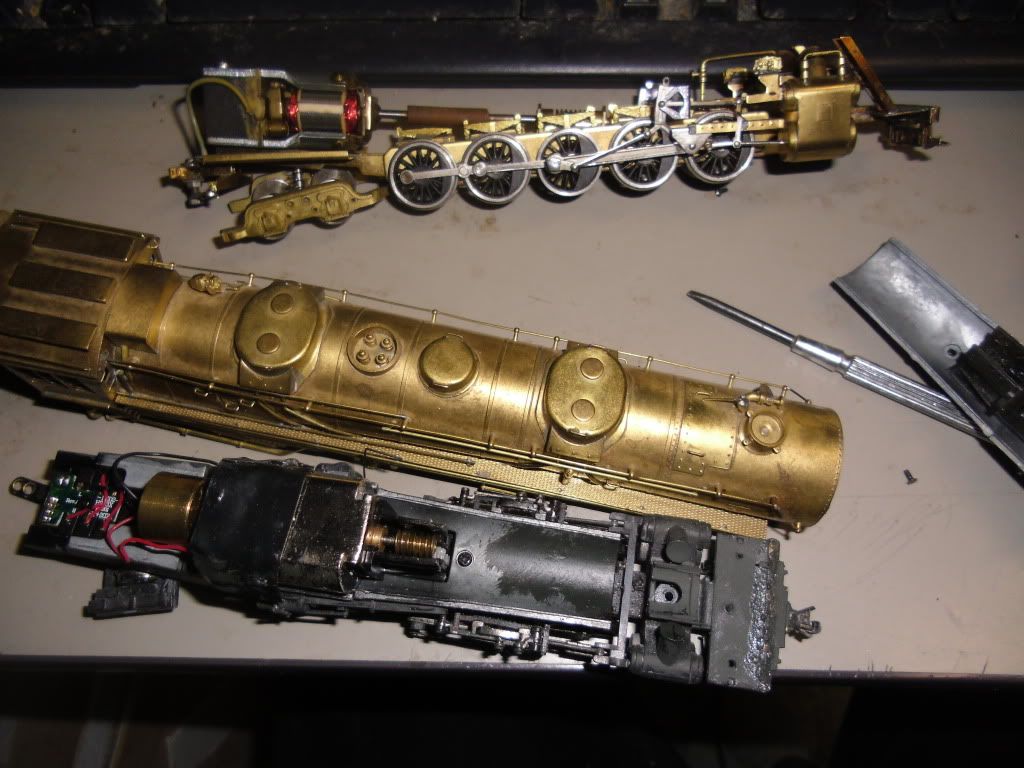
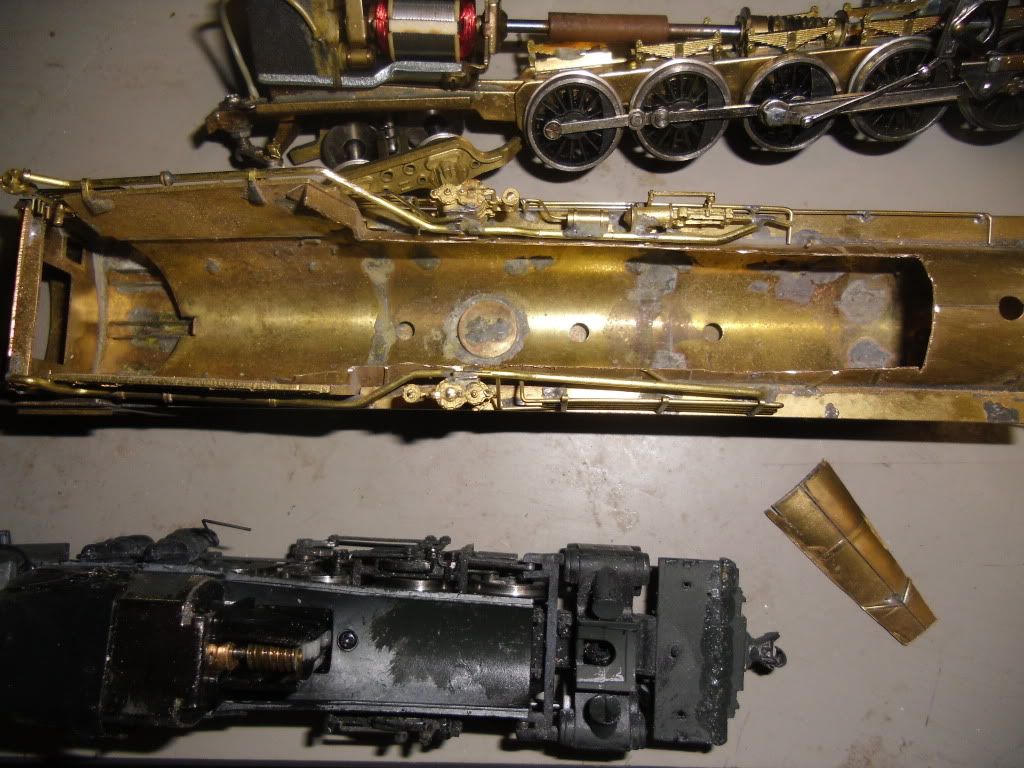

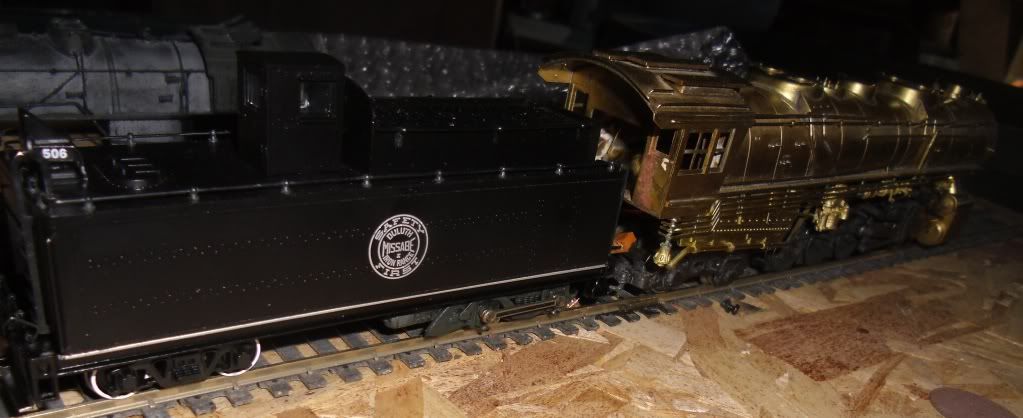


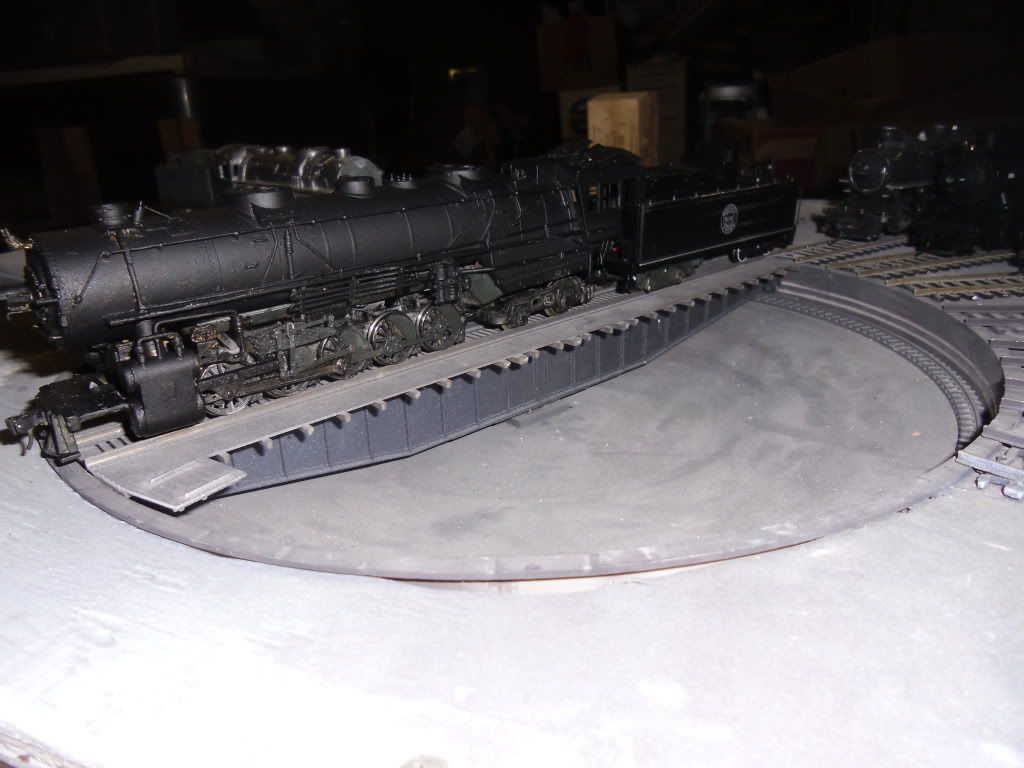
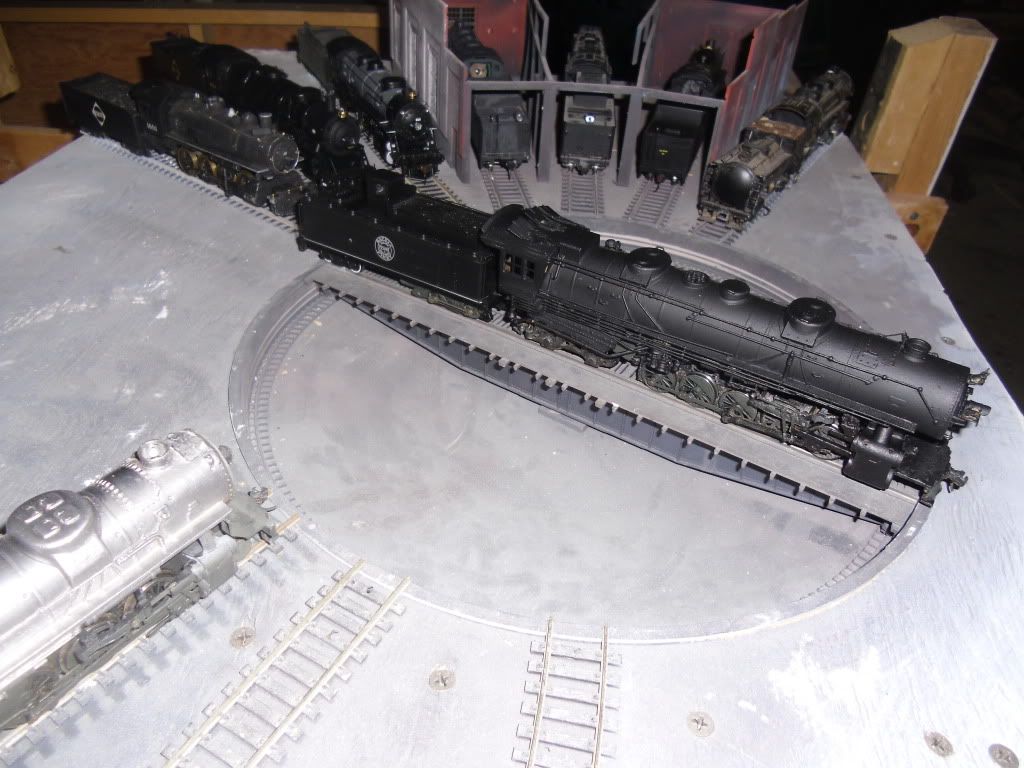
It was considered too large an engine for a heavy switcher's tender so the tender went off to a 0-10-0(which was another brass engine with a bachmann russian decapod chassis)
So a D&RGW tender from an L-131 2-8-8-2 was bought to replace it in it's stead:


The engine was give some number boards and other details and painted D&RGW style, but I was still not satisfied, the engine was really lacking the character I wanted:

So finally with existing parts I had from other projects and a D&RGW M-75 4-8-2 taking a nose dive off the work bench(a blessing in disguise) The boiler front of the M-75 was reworked and repaired and fitted onto the monstrosity and gave the engine new life with a better look, the pilot was replaced with a Varney Casey Jones pilot and brass sheeting from my 2-6-6-0 leftover was used to make an extra set of steps. The original LMB Pilot truck was then used as the front pilot truck.





I have to say with all the tinkering I've done with this locomotive, the actual final look makes me really satisfied with the way things have turned out,this engine went from being something neat but not completely appreciated, to just an abandoned side project, to eventually getting the recognition it finally deserves as a neat piece of art, I love it now and proud of my work.
For anyone who has abandoned a project locomotive or similar kitbash and gave up because you didn't get the results you wanted I hope this inspires you to think outside the box and give an idea new light!




I didn't like the tender, and the running capability of the locomotive left much to be desired, so it went off to the Kitbasher's torch








It was considered too large an engine for a heavy switcher's tender so the tender went off to a 0-10-0(which was another brass engine with a bachmann russian decapod chassis)
So a D&RGW tender from an L-131 2-8-8-2 was bought to replace it in it's stead:


The engine was give some number boards and other details and painted D&RGW style, but I was still not satisfied, the engine was really lacking the character I wanted:

So finally with existing parts I had from other projects and a D&RGW M-75 4-8-2 taking a nose dive off the work bench(a blessing in disguise) The boiler front of the M-75 was reworked and repaired and fitted onto the monstrosity and gave the engine new life with a better look, the pilot was replaced with a Varney Casey Jones pilot and brass sheeting from my 2-6-6-0 leftover was used to make an extra set of steps. The original LMB Pilot truck was then used as the front pilot truck.





I have to say with all the tinkering I've done with this locomotive, the actual final look makes me really satisfied with the way things have turned out,this engine went from being something neat but not completely appreciated, to just an abandoned side project, to eventually getting the recognition it finally deserves as a neat piece of art, I love it now and proud of my work.

For anyone who has abandoned a project locomotive or similar kitbash and gave up because you didn't get the results you wanted I hope this inspires you to think outside the box and give an idea new light!


#143
HO / Model: 852X-OOFO1-1 Complete Truck (45 Ton)(HO Scale)
August 10, 2013, 02:10:29 PM
Any chance these trucks will be restocked in the parts store? I really need a few of these, and I don't want to have to buy the actual locomotive to get them.
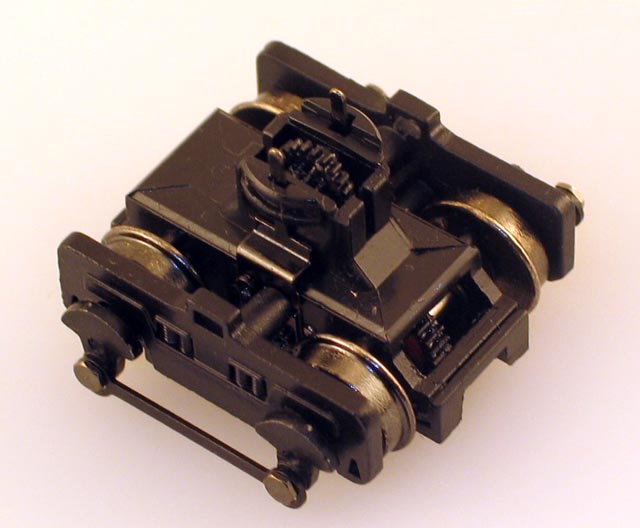

#144
HO / Re: What if Bachmann made a 2-6-6-0?
August 10, 2013, 02:06:24 PM
wow those CPR 0-6-6-0's were pretty interesting I must say
J3a,
those VGN 2-6-6-0's look pretty similar to the D&SL engines with the exception of the boiler tapering
Ifeel like so much can be done with the bachmann 2-6-6-2 chassis, I have plans to make a D&RGW L-67 2-6-6-2 and a Ex-N&W 2-6-6-2 using the same chassis



I have an L-62 I made from a mantua chassis but the drivers are too small and the engine sits too low so I'm not satisfied, although I will keep the engine the way it is anyways

J3a,
those VGN 2-6-6-0's look pretty similar to the D&SL engines with the exception of the boiler tapering
Ifeel like so much can be done with the bachmann 2-6-6-2 chassis, I have plans to make a D&RGW L-67 2-6-6-2 and a Ex-N&W 2-6-6-2 using the same chassis



I have an L-62 I made from a mantua chassis but the drivers are too small and the engine sits too low so I'm not satisfied, although I will keep the engine the way it is anyways

#145
HO / Re: What if Bachmann made a 2-6-6-0?
August 07, 2013, 12:10:55 PM
Thank Jonathan,
I'm a bit surprised you haven't done anything like a 0-6-6-0 yet, have you ever seen the B&O 2-6-6-4's???
K487,
indeed, but if you dig deeper like they could make an 0-6-6-0 early version of this type of locomotive like for the Denver Northwestern and Pacific:

You can tell already the unique differences like the tender, the headlight and the steam pipes, makes for a good turn of the century mallet and then later when The Denver and Salt Lake took over they added lead trucks to the engines for better tracking

as time went on you saw modernization with the Denver and Salt lake


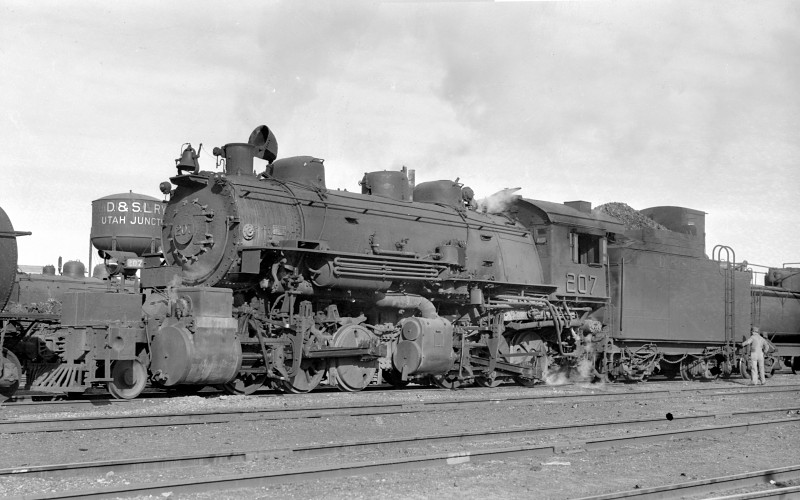
And then their final incorporation into the D&RGW where they ran til their final days:
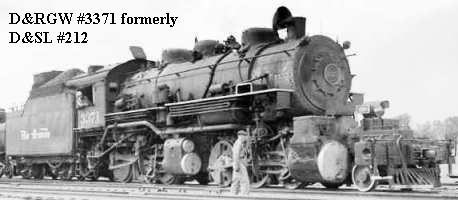
Essentially you could have 8 different engines, from the same prototype with 3 different roadnames and potentially some made up ones. The engines went through all sorts of cosmetic changes if you notice in the photos, which would be perfect for bachmann because they can offer variety for modelers who model early-golden age or late steam just based on different details alone
I'm a bit surprised you haven't done anything like a 0-6-6-0 yet, have you ever seen the B&O 2-6-6-4's???
K487,
indeed, but if you dig deeper like they could make an 0-6-6-0 early version of this type of locomotive like for the Denver Northwestern and Pacific:

You can tell already the unique differences like the tender, the headlight and the steam pipes, makes for a good turn of the century mallet and then later when The Denver and Salt Lake took over they added lead trucks to the engines for better tracking

as time went on you saw modernization with the Denver and Salt lake


And then their final incorporation into the D&RGW where they ran til their final days:

Essentially you could have 8 different engines, from the same prototype with 3 different roadnames and potentially some made up ones. The engines went through all sorts of cosmetic changes if you notice in the photos, which would be perfect for bachmann because they can offer variety for modelers who model early-golden age or late steam just based on different details alone
#146
HO / Re: What if Bachmann made a 2-6-6-0?
August 05, 2013, 10:54:01 PM
thanks guys,
basically the N scale model's boiler and tender were printed, the original frame of the 2-6-6-2 had to be milled down so the boiler slips right on. I didn't make the model, Matt Myers off South Boulder Modelworks designed it, and a 3D printing company makes it, right now it's still being beta tested, but I'm looking to write an article soon on the construction of this model as I have another one lined up to do so
I don't have a 3D printer but if I did, I would probably be doing a whole lot more
basically the N scale model's boiler and tender were printed, the original frame of the 2-6-6-2 had to be milled down so the boiler slips right on. I didn't make the model, Matt Myers off South Boulder Modelworks designed it, and a 3D printing company makes it, right now it's still being beta tested, but I'm looking to write an article soon on the construction of this model as I have another one lined up to do so

I don't have a 3D printer but if I did, I would probably be doing a whole lot more

#147
HO / What if Bachmann made a 2-6-6-0?
August 05, 2013, 03:18:55 PM



in HO and N Scale
I'll give you a hint, both locomotives have Bachmann 2-6-6-2 Chassis.
The HO one was made from parts from a PFM Brass Model and the N Scale one was developed using 3D Printing Technology
It's a Denver and Salt Lake 2-6-6-0. Some of them were built as early as 1909 they were used on Rollins Pass in Colorado. They were double headed quite frequently with themselves and 2-8-2's and 2-8-0's and were known to do 55MPH with a moderate sized freight behind it. When The D&RGW acquired them they were put to good use and ran until they were scrapped in the 1950's
The unique thing about these engines is they all have had a multitude of modifications done to them over the 4 decades they were around, so not all of them looked the same either. The HO version being created to look similar to D&RGW #3371 but with the ladders on the tender. I have another N scale engine that's modified already and going to be painted and lettered for #3371
These are really fun engines, I must say

#148
HO / Re: HO scale K-27
August 05, 2013, 01:08:50 PM
if you're looking for a K-27 that runs on HO Track, I think Sn3 models do, but be prepared to pay brass prices, not to mention they aren't 1:87.5 scale either sso it would look out of place unless you had S scale stuff
#149
HO / Re: New announcement
July 30, 2013, 05:28:48 PMQuote from: jettrainfan on July 30, 2013, 12:00:27 PM
Couldn't they also be used for heavy switching on a terminal railroad or a switching layout? Heck, if worse comes to worse, a steam engine for excursions on a short line.wasn't there a 4-6-6 back in the 70's & 80's that was hauling passengers? I used to have a video that featured it, but not anymore.
Heavy switching was primarily done by 0-8-0's and 0-10-0's
Notice that the commuter tank engines were built with a shorter drive wheelbase, heavy switching would have been out of the question, you would need buckets upon buckets of extra sand to handle the wheel slip.
Tank locomotives in many yards were used mostly for engine servicing or small switching duties. Most effective designs had 6 to 8 driving wheels but wouldn't go very far without a coaling/oil/water fueling station in the direct vicinity of it's operation.
The D&RGW had actually converted one of it's consolidations into such a locomotive.
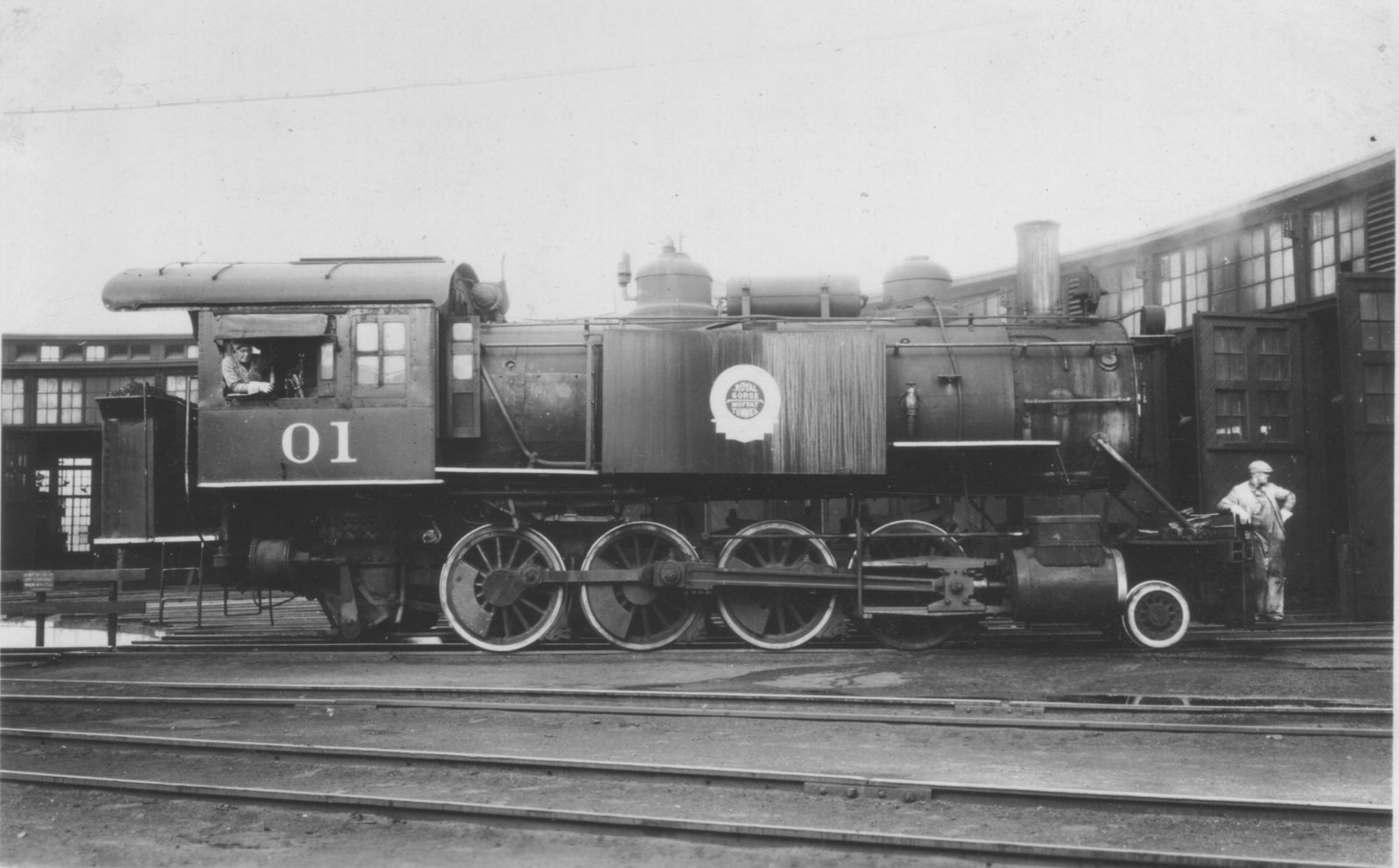
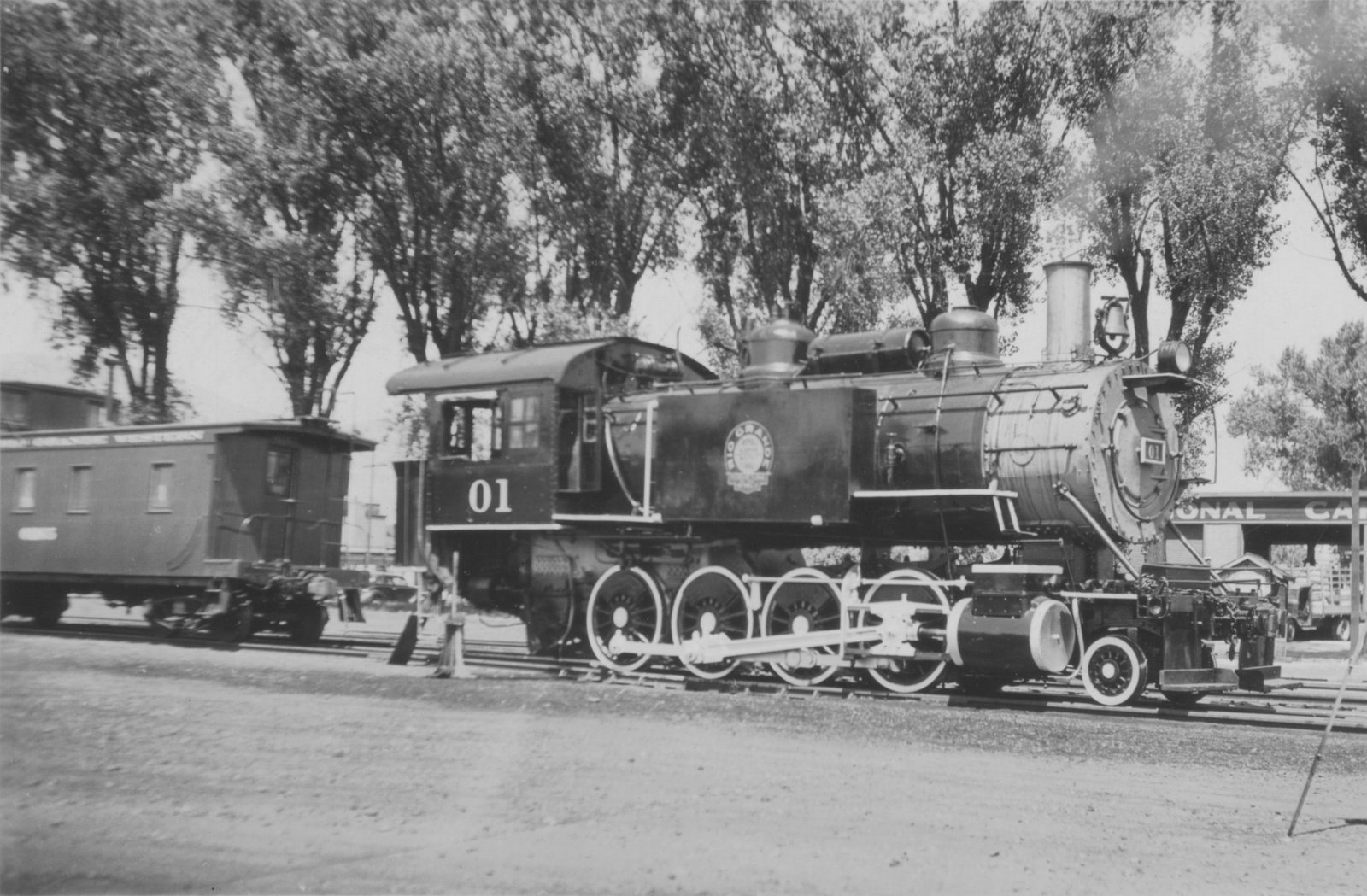
"D&RGW #01 was an oddball. It started life as D&RG 905, a Class 185 standard gauge 2-8-0 made by Baldwin. With the great renumbering by the D&RGW in 1924, it became Class C-41 #955. In 1937, it was the only unit of its class converted to a 2-8-0T tank engine for switching duties around the Salt Lake, UT shops. After this remarkable transformation, it became the #01."
As quoted from DRGW.net
#150
HO / Re: New announcement
July 29, 2013, 11:14:58 PM
Many of you don't realize, standard gauged forney's and that ilk were primarily commuter engines, which most of the time only pulled 2-3 short coaches
the CNR/CNJ 4-6-4t
or the B&A 2-6-6t/4-6-6t's were really handsome locomotives and are sought after brass items, I still haven't been able to nab one, but it's on my to-get list
the CNR/CNJ 4-6-4t
or the B&A 2-6-6t/4-6-6t's were really handsome locomotives and are sought after brass items, I still haven't been able to nab one, but it's on my to-get list
